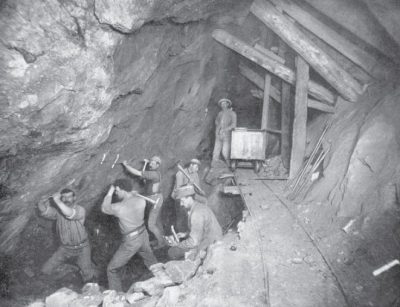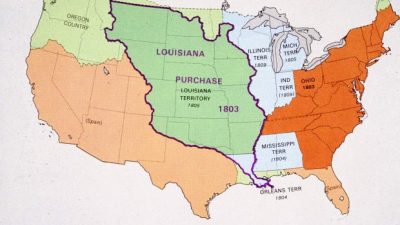The Western Lands Issue
Part 2
by Ron Nielsen
In part 1 we reviewed the Northwest Ordinance and its purpose as enacted legislation that established a legal framework for the creation of Territorial legislatures and judiciaries and the subsequent process for conversion and acceptance as new states of the union.
We also discovered that the Northwest Ordinance language reveals an intent for the Articles of Confederation system to act as a sort of holding or trust for all the lands acquired under the NWO’s operation.
We also talked about the debates in Congress over the Louisiana purchase and how Congress decided to apply Article 4 section 3 clause 2 of the Constitution to give authority to the Constitutional government to hold land.
In part 2 I would like to introduce a new work, a Book entitled ‘The right of Territories to become states’. The reason we are going here will become apparent as we proceed. It may seem a little premature to go this direction at this stage but unfortunately it is important to lay this foundation before we go any further.
I highly recommend reading this Book as much of the tone of it assists in understanding the dominant mentality that created this issue, in other words; it helps to understand how these people were thinking as we ferret out the evidences we are looking for. I also recommend looking into the authors biography.
Edmund points to a varied system in which the Territories applied for and were granted, statehood. There was seemingly no set of parameters that were used to gauge admission by Congress and Edmund goes on to write about the NWO on page 10 stating, “Soon after its cession (the lands in the treaty of Paris) Congress passed an ordinance for its government, which was succeeded by the more famous ordinance of 1787.
These ordinances are important to the treatment of our subject, as they contain, besides the stipulation for the admission of states, the forms and provisions that appear in most of the enabling acts. And of course, a little further down we get some familiar language again, “The clauses provided that the states should forever remain a part of the confederacy”.
 The agreement between different authors as far as that one particular policy is what grabbed my attention here and it became clear that this policy was well known at one time. The conclusion that Edmund reached was that admission and conversion into statehood was a political process.
The agreement between different authors as far as that one particular policy is what grabbed my attention here and it became clear that this policy was well known at one time. The conclusion that Edmund reached was that admission and conversion into statehood was a political process.
This is important because the current situation of lands are just lands that have retained their Territorial character since they were received. To aid us in understanding this we will now view Idaho’s admission act.
When reading Idaho’s admission act it becomes obvious that the main concern was schools and education. An ‘endowment’ fund was set up using the funds from the sale of the school lands in order to fund public schools. In section 11 the act lays out the specific land grants and doing some quick math you come up with 500,000 acres so lets just stop here for a moment.
Prior to this allocation of land the character of the land was what? It was Territorial, so then what is the character of the unappropriated lands? Still Territorial. The unappropriated lands have NEVER changed their character from the date they were acquired till now which means they are under the Articles of Confederation system right?
Section 12 of Idaho’s admission act states, “The state of Idaho shall not be entitled to any further or other grants of land for any purpose than as expressly provided in this act”. The federal Government controlled how much land Idaho was to receive as a State and also controlled the manner in which the lands were to be used.
The federal Government did not originally intend for the people to harvest mineral resources from state land and so they exempted mineral lands in section 13, “All mineral lands shall be exempted from the grants by this act. But if sections 16, 36 or any subdivision, or portion of any smallest subdivision, thereof, in any township, shall be found by the department of the interior to be mineral lands, said state is hereby authorized and empowered to select, in legal subdivisions, an equal quantity of other unappropriated lands in said state, in lieu thereof, for the use and benefit of the common schools of said state”.
Section 16 and 36 that were areas within mineral lands and it is possible that they were aggregated and reassigned to forested areas of the state. This is where the state receives about $35 million per year in timber sales.
While a part of the intent of Congress was that the state not have mineral lands, Congress shows its full intent by making the lands public lands, passing the 1872 mining law and Organic administration act of 1897. The general government had all the lands surveyed and reconnaissance geological work done to determine the possible wealth of its holdings. Once an idea of the wealth of the west was determined Congress made the lands available (to itself and its posterity) by keeping the lands public.
 Now of interest to us in this assessment is that the 1872 mining law allowed the patenting of mining claims if a valid discovery was made and improvement were made to the claim. So, some land was disposed by this Act. It is also interesting to note that the Homestead Act of 1863 provided the public a means to patent land but not on mineral lands only as farm tracts.
Now of interest to us in this assessment is that the 1872 mining law allowed the patenting of mining claims if a valid discovery was made and improvement were made to the claim. So, some land was disposed by this Act. It is also interesting to note that the Homestead Act of 1863 provided the public a means to patent land but not on mineral lands only as farm tracts.
We must understand that very few regular people in the newly expanded west had the monetary and intellectual capability to put successful logging and mining companies together and Congress had NO INTENTION of allowing the western states to become economically powerful by extracting its own resources, no the West was rich in resources and Congress made sure the Eastern states got some of the pie, all things being equal you see.
(To see the attitude of the Eastern states peoples regarding the western lands I suggest reading the debates over the Louisiana purchase in the report from the previous write up)
But our purpose here is to consult the admission act as to the terms of admission since the lands were under a separate system for holding and we want to specifically know how much land was granted and what was the character of the unappropriated lands. What is the status of the lands now?
In 1989 Congress amended the admission act and in this amendment they admitted that 3.5 Million acres were being held in endowment, of course the language serves to create the idea that the Federal Government is providing a service to the state by holding the lands,
“In writing the 1890 law that made Idaho the 43rd State, Congress set aside 3.5 million acres of land as a permanent endowment to help finance the education of Idaho children in the 20th century. These lands are spread throughout the State, and are managed for the financial benefit of Idaho. The Idaho Admission Act is very specific about how these lands are to be administered. While these restrictions worked well in 1890, some of them have now become outdated.”
The term ‘endowment’ was used in the admission act and its appearance here gives the impression that the lands were given to the general government as a gift or donation and all I can tell you is THAT never happened.
From Idaho’s admission act on I have found not 1 scintilla of evidence to support this type of endowment, all the evidence supports that the federal government has had control since acquisition and merely granted small amounts of lands to the state upon admission. I have challenged many people over the years to produce the necessary documents for the transfer of ownership from the federal government to the various State political subdivisions of vast amounts of land.
A land transfer of this magnitude would certainly have drawn interest from the press as well…to this day not 1 single piece of evidence has surfaced that this occurred. No, the endowment appearing in the Admission act clearly demonstrates the federal government being the donating entity here and ONLY the funds from the sale of lands were the endowment NOT the land.
Now that we have broached the subject of admission acts we also need to take note that each admission act had variations within the acts, what do I mean here? You will note that Idaho and Montana’s admission acts give different impressions about the future of the lands. In the case of Montana the Federal government stated,
“That the people inhabiting said proposed States do agree and declare that they forever disclaim all right and title to the unappropriated public lands lying within the boundaries thereof, and to all lands lying within said limits owned or held by any Indian or Indian tribes; and that until the title thereto shall have been extinguished by the United States, the same shall be and remain subject to the disposition of the United States, and said Indian lands shall remain under the absolute jurisdiction and control of the Congress of the United States;”.
This language is missing from the Idaho admission act. One is left wondering exactly what was the intent here? Was the intent to extinguish Title in the future for Montana and North Dakota but not Idaho? Remember, every states admission into the union was a political process and so one must also be tempted to believe that the extinguishing of title is ALSO a political issue thereby making extinguishing title, disposal, whatever you want to call the handing control of the lands finally over to the state, first and foremost a political matter.
We will discuss this at the end of our series as it is the REASON why we are even reading this or any other works, the people want to know HOW the state gets control over the lands within her geographic boundaries. I suggest reading admission acts from different states so that you can see the variations between these different documents which will assist you in seeing the ‘political nature’ of this entire thing.
An example of a political strategy would be that if the federal government admitted its intent to extinguish title to one states political subdivisions surely (for optics purposes) it does not intend to disadvantage other states under the ‘equal footing doctrine’ does it?
For optics purposes no politician in their right mind would publicly announce there was an intent to extinguish title for one state and not another, it would be political suicide and would prove that there are political limitations on the use of the ‘equal footing doctrine’ thereby making states, in fact, unequal.
The existence of the written intent in Montana’s enabling legislation gives substantial ammunition to whomever attempts to bring this matter to Congress.
In the part 3 we will turn to the different treaties that affected disposition of the lands and the peoples on them.

Visit Idaho On Fire
The views, opinions, or positions expressed by the authors and those providing comments are theirs alone, and do not necessarily reflect the views, opinions, positions of Redoubt News. Social Media, including Facebook, has greatly diminished distribution of our stories to our readers’ newsfeeds and is instead promoting Main Stream Media sources. This is called ‘Shadow-banning’. Please take a moment and consider sharing this article with your friends and family. Thank you. Please support our coverage of your rights. Donate here: Paypal.me/RedoubtNews







“Remember, every states admission into the union was a political process and so one must also be tempted to believe that the extinguishing of title is ALSO a political issue thereby making extinguishing title, disposal, whatever you want to call the handing control of the lands finally over to the state, first and foremost a political matter. ”
When the criminals take-over they know how to indoctrinate each successive generation into accepting arbitrary (criminal) government. That explains how people today have trouble understanding basic moral principles that govern people, such as the Golden Rule.
Previous to the criminal take-over of America in 1789 the people themselves voluntarily agreed to apply common, moral, principles, doing so at grass-roots, and doing so organically. People created voluntary mutual defense associations, in towns, cities, counties, and states. The people hired (elected) to run the towns, cities, counties, and State governments. Those elected to represent the whole people then framed, formed, and created a Federation (confederation) of States to defend against the arbitrary government of Britain. That was all done on the voluntary, moral, basis, and the proof of this is extensive, including the efforts to end the crimes known as African Slavery.
Homesteading was the moral way by which individuals, families, businesses, or corporations acquired allodial title to land within the voluntary associations formed, framed, for mutual defense against all enemies foreign and domestic. Homesteading was exemplified by the early settlers: improve vacant land, defend it, and establish property rights by that improvement, and that defense. The process by which any, and every, controversy among the volunteers was trial by jury according to the common law, which included the adaptation of assembling independent grand juries to investigate accusations of crimes perpetrated by criminals.
So now, after over 200 years of rule by the criminals, people just accept as fact that human relationships are involuntary and everyone, everywhere, is subject to arbitrary rule by these criminals, and everyone, everywhere must obey without question or be deported, or run from this form of (legal fiction) slavery. Where can people run from this form of slavery since the criminals took-over in 1789?
That type of indoctrination is just so much fertilizer, as is this investigation into what has happened to common laws regarding allodial title of land, for individuals, for groups of individuals in cities, counties, and states. So much fertilizer keeping people in the dark like mushrooms.
The actual founders of the actual federation of states actually formed republics, meaning that the voluntary mutual defense associations were actually for the whole people, the public, and not for special interest groups like central bankers, warmongers, and slave traders.
If people give absolute power to criminals posing (counterfeiting) as “the government,” what do you think those criminals will do with our lives, property, and liberty?
January, 1782
“Congress having resolved on the seventh day of August last that in case they should recognize the independence of the people of Vermont they would consider all the lands belonging to New Hampshire and New York respectively without the limits of Vermont aforesaid as coming within the mutual guaranty of territory contained in the Articles of Confederation and that the United States will accordingly guarantee such lands and the jurisdiction over the same against any claims or encroachments from the inhabitants of Vermont aforesaid and having on the twentieth day of the same month required as an indispensable preliminary to the recognition
of the independence of the people inhabiting the territory aforesaid and their admission into the federal Union the relinquishment of all demands of lands or jurisdiction on the East side of the West Bank of Connecticut River and on the West side of a line beginning on the North West Comer of the State of Massachusetts thence running twenty miles East of Hudson’s River so far as the said River runs North Easterly in its general course, then by the West bounds of the township granted by the late Government of New Hampshire to the river running from South Ba}” to Lake Champlain thence along the said river to Lake Champlain thence along the waters of Lake Champlain to the latitude of forty five degrees North excepting a neck of land between Missiskoy Bay and the waters of Lake Champlain.”
http://unionstatesassembly.info/journals/journals%20of%20the%20continental%20congress%201774-1789%20vol%2022%20jan%201%20-%20aug%209%201782.pdf